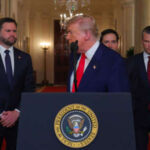Did you know that Truthout is a nonprofit and independently funded by readers like you? If you value what we do, please support our work with a donation.
As an Iranian, I felt a surge of relief — and cautious hope — when I heard news of the ceasefire between Iran and Israel. The bloodshed had gone on for 12 long days. The killing, the airstrikes, the relentless tit-for-tat violence — it all had to stop. If for nothing else, for the sake of the people on both sides. Now, of course, Israel’s massacre in Gaza must end, too.
But even in that moment of relief, my mind was flooded with uneasy questions:
- Would this ceasefire hold? Could it? With no clear picture of the damage inflicted on Iran’s nuclear facilities after the U.S. attacks, are we facing more skirmishes — or something far worse?
- Will Iran and the U.S. negotiate in good faith about the future of Iran’s nuclear program?
- And then, the hardest question of all, the one that keeps circling back no matter how many times we push it aside: What happens now to the political fervor within Israel and the U.S. to bring about regime change in Iran?
As for the first question, I could only hope the ceasefire holds and that Iran and Israel avoid further military escalation. Skirmishes may still flare — history tells us as much. But a full-scale war? I doubt it. The sheer destruction and loss of life on both sides have already taken a staggering toll. Iran’s health ministry says that 610 people were killed in the war; rights organizations put the estimate closer to 950. Meanwhile, 28 Israelis were killed. Experts also say that Iran’s missile stockpiles are running low, just as Israel’s supply of interceptors is being depleted.
Don’t miss a beat
Get the latest news and thought-provoking analysis from Truthout.
As for the prospect of another U.S. strike on Iranian soil — especially after Donald Trump’s controversial bombing of Fordow, Iran’s heavily fortified nuclear facility buried deep within a mountain — it seems unlikely. The political backlash he faced from parts of his own base was immediate and fierce. Even Donald Trump, no stranger to reckless moves, may think twice before doing it again.
The second question is more difficult to answer: Can Iran and the U.S. ever negotiate in good faith over Iran’s nuclear development program? To be fair, Iran, for its part, has tried three times — and each time, it was deceived by Donald Trump.
The first betrayal came when Trump, during his first term, unilaterally tore up the Joint Comprehensive Plan of Action, a multilateral agreement that had capped Iran’s uranium enrichment at 3.67 percent and placed its nuclear program under the full surveillance of the International Atomic Energy Agency.Iran had complied with every condition. So why did Trump abandon it? Because it was Obama’s deal, and in his eyes, that alone made it unacceptable.
The second betrayal came not long into Trump’s second term, when his administration offered Tehran a proposal similar to Obama’s, assuming Iran would fold. According to credible reports, the two sides had reached a broad agreement and were preparing to meet on June 15. But on June 13, Israel launched an unprovoked surprise attack on Iranian soil — an act many believe was carried out with Trump’s tacit approval, if not direct coordination — sabotaging the talks.
Then came the third betrayal. On June 19, Trump issued a two-week ultimatum, demanding that Iran “come to its senses” and agree to a new deal. Just two days later, without congressional approval or international support, he launched another illegal strike — targeting Natanz, Isfahan, and Iran’s deeply fortified nuclear facility in Fordow.
And then, came the spectacle.
Trump stepped to the podium in a made-for-TV moment — part Obama announcing Osama bin Laden’s death, part George W. Bush beneath a “Mission Accomplished” banner. The theatrics were familiar. So was the premature triumphalism. With the swagger of a mob boss and the flair of reality TV, he declared that now that Iran’s nuclear capabilities had been “completely and totally obliterated,” it was time for Tehran to “make peace.”
But the illusion of success unraveled quickly. According to The New York Times, citing classified U.S. intelligence, the strikes may have set back Iran’s nuclear program by only a few months. The attack on Fordow sealed off entrances to two tunnels but failed to collapse the underground structures where enrichment occurs. The core of the program remains intact.
Trump may be perfectly content with that outcome. After all, no one — except Israeli Prime Minister Benjamin Netanyahu, Trump himself, and their band of loyalists — ever truly believed Iran’s nuclear program was a non-peaceful development. That fiction has long been used as a political tool, not a strategic truth. And now, with a ceasefire in place and a headline-ready performance behind him, Trump may once again be ready to talk (or pretend to).
But wait! What are his counterparts in Iran thinking now?
Fool me once. Shame on you. Fool me twice. Shame on me. Fool me three times? No one should trust you — ever!
There’s a powerful faction within the Iranian regime that has long argued negotiations with the United States are futile — that every overture will be met with betrayal. After three failed attempts, their case may have just gotten stronger. Would they prevail? Would Iran now pursue a weapons program as a deterrent? That’s quite possible.
Let’s hope they don’t try, and let’s also hope that against the odds, Trump keeps his word this time.
Now, to the most difficult question: What happens to the joint Israeli-U.S. dreams of regime change?
A regime change through foreign intervention is near impossible in Iran. In fact, Trump and Netanyahu have accomplished what the Islamic Republic itself failed to do in 45 years — unite the Iranian people. Even some of the regime’s most outspoken critics, including Nobel laureate Narges Mohammadi and jailed reformist politician Mostafa Tajzadeh, called for an end to the war. They, along with many activists in the diaspora, are now rallying in defense of Iran.
I say Iran, not the flag or the regime, because nearly everyone outside the hardliner faction supports either sweeping reform or a full change in government. But they also agree that they do not want a regime change imposed by foreign powers. Not by bombs. Not by invasions. Not by exiles with microphones and no mandate.
The only prominent political faction still clinging to the fantasy of regime change by force is the group of opportunists orbiting Reza Pahlavi — the exiled son of Iran’s deposed shah. A relic of a bygone era, Pahlavi commands a shrinking, disconnected base. He left Iran as a teenager, and stories of his youthful indulgences are the stuff of tabloid lore. His long-standing pursuit of the throne has been marked by missteps, contradictions, and political insensitivity. In 2023, he traveled to Israel to meet with Prime Minister Benjamin Netanyahu, in an attempt to curry favor from the state that has long threatened to conduct military strikes against Iran. And in the past 12 days, while millions of Iranians prayed for peace amid escalating violence, Pahlavi applauded Israeli actions over and over again. But if there’s one thing Iranians don’t forget, it’s betrayal. And for many, celebrating bombs dropped on your homeland is exactly that. As one guest said on CNN this week, Pahlavi “looks more like Ahmad Chalabi than George Washington,” referring to the Iraqi politician who urged regime change in the early 2000s from the comfort of his own home in the United States.
So, let’s get serious: What would a regime change look like? Not the Hollywood version. Not the “liberation” dreams sold to exiles on satellite TV. The real version would be the one soaked in blood, chaos, and long-term devastation. The Iraq-and-Afghanistan version.
Besides, military-driven regime changes usually start with a foreign power wrapping its ambitions in the flag of “liberation.” Remember Afghanistan in 2001? Iraq in 2003? The U.S. didn’t just drop bombs and go home. It spent months building coalitions, gathering intelligence, and deploying hundreds of thousands of troops. And what followed wasn’t peace. It was a quagmire. Trillions of dollars later, both countries were left broken. ISIS (also known as Daesh) famously grew out of the instability the U.S. left in Iraq. In Afghanistan, the Taliban seized power back again.
And Iran is no Iraq. It’s nearly four times larger in size and double the population, with a stronger national identity and a more complex social fabric. Any attempt at invasion or occupation would demand a military mobilization, unlike anything the U.S. has undertaken in modern history. And even then, it would fail.
Then comes the next phase: collapse from within. Take Libya. NATO bombed Muammar Gaddafi out of power in 2011. Western leaders cheered. The result wasn’t democracy but chaos. The country disintegrated into militia-run fiefdoms, enslavement, and civil war.
Apply this to Iran, and the picture gets even darker. Without a central government, separatist movements in Kurdistan, Khuzestan, Sistan and Baluchestan, and even Azerbaijan could be armed and emboldened by foreign interests. The result? Balkanization. Ethnic warfare. Prolonged instability.
And please, let’s dispense with the fairytale that Pahlavi — or any exiled figure — could return to “liberate” Iran. Resistance from regime loyalists, militias, or simply civilians defending their neighborhoods would make any such attempt suicidal. Just as loyalists to Saddam Hussein regrouped into insurgents and Gaddafi supporters fought on, the forced collapse of the Islamic Republic would spark a civil war, not a coronation.
So, regime change through foreign intervention is neither possible nor desirable. But an organic, homegrown transformation by the people of Iran, for the people of Iran, remains within the realm of possibility. Iran has been suffocating under debilitating sanctions for more than four decades. This war will only deepen the suffering. Will Iranians, already traumatized by violence and repression, have the will or energy to rise in the immediate aftermath of another conflict? Perhaps not. But the ground could shift down the road. Public discontent may harden into renewed resistance.
The danger, however, is that in the absence of a peaceful, civilian-led transition, a military coup could fill the vacuum, pushing Iran even further away from the possibility of democracy. That would be the ultimate tragedy: trading one authoritarian regime for another, and silencing the hopes of a nation that has fought so long and lost so much in pursuit of freedom.
Fundraiser Deadline: 24 Hours
Truthout urgently appeals for your support. Under pressure from an array of McCarthyist anti-speech tactics, independent journalists at Truthout face new and mounting political repression.
We rely on your support to publish movement journalism — in fact, we’re almost entirely funded by readers like you. Yet, donations are down at this moment of crisis. We may end this month in the red without additional help, so we’ve launched a fundraiser.
We have 24 hours to hit our $19,000 goal. Please contribute a tax-deductible gift to Truthout at this critical moment.
Read full article at source
Stay informed about this story by subscribing to our regular Newsletter


